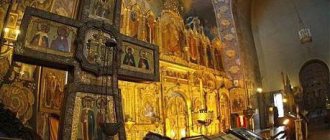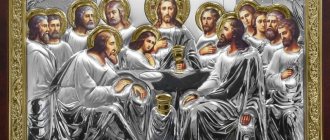Bible Questions and Answers
Published 10/09/2013
In Christianity there is the concept of the “Holy Trinity” - what explanation can be given for this definition according to the Bible? How can you explain to me the principle of the trinity of God in simple words? How can the Holy Spirit, Jesus, and God be separate individuals and yet one? What is the essence of the Trinity?
Answer:
There are literally hundreds of passages in the Bible, both the Old and New Testaments, that there is only one God. Christianity is a religion of monotheism, not tritheism. In my answers to difficult questions you will find a list of perhaps fifty passages. Paul tells us that there is only one God. I will quote Deuteronomy 6:4, which is worth hundreds of passages that absolutely state that there is one God: “Hear, O people of Israel! The Lord is our God, the Lord is one!”
What is “hypostasis” and when did this term appear?
Hypostasis is a theological Orthodox term, the meaning of which implies a unique distinctive feature of each of the three Persons of the Holy Trinity, which is one.
Initially, the word “Hypostasis” appeared in philosophy and translated from Greek means nearby, stand or foundation, in Latin - substance, existence. In theology, this term denotes a specific person or object that has its own individuality, in which the essence is realized.
Hypostasis is a term in Orthodox theology that is used to explain the doctrine of the Holy Trinity
In everyday life, it is understood as existence, individual being. According to the teachings of the philosopher Plotinus, this word meant the essence of something, but was not a term denoting personality. In Orthodox theology, this concept is accepted to describe the essence of God in three Persons.
The Fourth Ecumenical Council gave a clear definition to the term “hypostasis”; it differed from the concept of “nature”, which demonstrates the real existence of the divine and human in Jesus Christ. However, this connection has not undergone changes either in essence or in characteristics.
The great Cappadocians, among whom Basil the Great, Gregory the Theologian, and Gregory of Nyssa stand out for their teachings, gave a clear distinction between the concepts of essence and hypostasis, general and personal.
Read about the saints:
- Life of Basil the Great
- Life of Gregory the Theologian
Important!
According to their teaching, everything in the Holy Trinity is common, and by hypostasis is meant the individuality of each holy Person. The great Cappadocians explained that God is a single indivisible essence, the Hypostasis is inherent in each Person of the Holy Trinity, combining the two concepts, they came to the emergence of the term “personality”.
The hypostatic nature of God the Son is expressed in Jesus Christ, Savior and Teacher.
Religion as the restoration of man's connection with God
At the end of the conversation, it would be appropriate to dwell on the issue of the emergence of religion. By the way, this word itself comes from the Latin verb religare, which means “to reunite.” In this case, we mean restoring the connection with God that was broken as a result of original sin.
Among historians, there are three main points of view regarding the emergence of religion. The first of them is called “religious”. Its supporters are of the opinion that man was created by God and, before his fall, had direct communication with Him. Then it was broken, and now for a person only prayer to God is the only opportunity to turn to his Creator, who reveals Himself through prophets, angels and various miracles.
Holy Scripture
The Old Testament mentions the word “hypostasis” 19 times. Genesis 18 describes Abraham's encounter with God. At the beginning of the story, the Lord is spoken of as an entity, but then Abraham meets messengers in three persons. Abraham addresses the Lord in the singular, calling Him Lord, but three strangers were sitting in front of him.
The word “hypostasis” in the Old Testament refers to various Hebrew words, but it is difficult to find a philosophical meaning in those expressions.
The New Testament contains 5 meanings of this word, most of all it is found in the book of Hebrews. Speaking about faith as the realization of the invisible, the word “realization” contains the meaning of hypostasis. (Heb. 11:1)
The verse (Heb. 1:3) describes the relationship between the Father and the Son in the radiance of the glory of the Savior and the image of His Person. It was this verse that attracted the attention of the Holy Fathers, becoming the cornerstone of the teaching on the theological term “hypostasis.”
In the Old Testament the word “hypostasis” is used 19 times, and in the New Testament - 5 times
John of Damascus argued that hypostasis means something that exists independently, and Thalassius of Libya saw in it a nature with personality properties, each individual has individual distinctive characteristics.
Archimandrite Cyprian saw in each Divine Person a way of the Existence of God.
One God - three hypostases
Saint Basil the Great in three Hypostases sees three modes of existence or tropos. According to his concept, in this case, existence is not just earthly life, but the existence of a certain personality endowed with uniqueness.
The Holy Fathers contrasted the tropos of existence, which can be known, with an unknowable understanding of nature.
Basil the Great speaks about each Hypostasis of the Holy Trinity about the particular and the general. The Holy Trinity has a common being, but the Persons have a unique feature.
According to the teachings of Gregory of Nyssa, the three Hypostases are distinct in God, but God is a single essence in which each Person has its own existence.
In the dogma of the birth of the Son through the Father and the origin of the Holy Spirit from God the Father, the monk emphasizes the mystery of the internal relationships of the three Persons in one God, His life in Himself, for what is born and what comes out has the same nature from which it is born and appears.
The Person of the Father is expressed in the Word:
- it existed forever;
- has no body;
- not visible to anyone;
- it cannot be touched.
This Word, which has no seed, is transferred by the Holy Spirit into the womb of the Most Pure Virgin, having received flesh from Her.
Hypostasis of the Son, Jesus Christ
If no questions arose with the nature of God the Father and the Holy Spirit, then in the Person of the Son of God two natural components are combined - Divine and human.
Jesus Christ unites in Himself two natures - Divine and human
Some clergy speak about a complex Hypostasis specifically in relation to Jesus Christ, and complexity, in this case, means consisting of two. Before coming to earth, the Essence was simple, uniform in nature. After the incarnation of God's Son into Jesus, it is called complex, that is, consisting of the Divine and the human. The two natures are represented by one hypostatic nature, but they cannot be separated; this connection is true and inseparable.
The two natures made up one complex Person of the Son of God, while maintaining individual differences. God remained immortal, but Jesus knew death. Previously, the Son of God was a simple Hypostasis without a body; he became Jesus, a complex personality with a dual nature.
According to the teachings of pagan philosophers, there is substance and nature. Substance is something common, but nature had differences; it can be rational and unreasonable, mortal and immortal. According to their conclusions, all people, animals of every species, angels belong to nature in general, and hypostases have individuality.
Important! According to the teaching of the Holy Fathers of the Church, nature is called substance, and the individual is called person.
Hypostasis is a substance that has accidents, can exist independently and is tangible through sensations.
Statements of Thomas Aquinas
In the 13th century, the outstanding Italian theologian Thomas Aquinas (1225-1274) tried to answer the question “what is God” and prove the indisputability of His existence. In his reasoning, he relied on the law of cause and effect, considering God as the cause of everything on earth. He formulated the evidence he derived for the existence of God in five points, which he included in a major work called “Summa Theology.” Briefly, they contain the following statements:
- Since everything in this world is in motion, there must be something that gave this process the initial impetus. It can only be God.
- Since nothing in the world can produce itself, but is always a derivative of something, we have to admit the existence of a certain primary source, which became the initial link in the subsequent chain of emergence of more and more new realities. This primary source of everything in the world is God.
- Each thing can have both real existence and remain in unrealized potential. In other words, it may be born, or it may not. The only force that translates it from potentiality into reality should be recognized as God.
- Since the degree of perfection of a thing can only be assessed in comparison with something superior to it, it is logical to assume the existence of a certain absolute that stands above everything in the world. Only God can be such a height of perfection.
- And finally, the existence of God is indicated by the expediency of everything that happens in the world. Since humanity is moving along the path of progress, it means that there must be some force that not only determines the right direction of movement, but also creates the necessary prerequisites for the implementation of this process.
What are accidents
Accidents are inherent in created beings; they can change. Every person changes with age, both externally and internally.
Everything that exists is divided into 2 components: substance and accident. Substance exists in itself, accident does not exist in itself, it can be seen in substance. Iron and chalk are substances, and their color differences are accidental. If the body is a substance, then color is expressed in the body, and not vice versa.
Personality differences that are characteristic of a certain type are called accidents, which means chance in Latin.
John of Damascus wrote that the two hypostases have different accidents, each of them is a characteristic of the individual. Each Person of the Holy Trinity has its own characteristics:
- There is no beginning and no end in the nature of God the Father. He was not born and does not go anywhere.
- God the Son was born from the Father outside of time, He is eternal.
- The Father sends the Holy Spirit, emanating from Him.
The personal existence of the God who created the world exceeds human reason
These are hypostatic properties, but not accidents, for in the Creator there is no accident, which underlies accidents. The Lord is unchangeable and non-random, we find confirmation of this in the Bible.
Read about the Bible:
- 15 Interesting Facts About the Bible
- How to read the Bible correctly and where to start
- Who is Judas Iscariot in the Bible
The Old Testament says that the Creator is not a man and human lies are not inherent in Him, everything that is said by God will be fulfilled (Numbers 23:19)
The prophet Malachi conveys the words of the Creator that the Lord does not change and, according to His word, the children of Jacob were not destroyed. (Mal 3:6)
The Apostle James in his letter emphasizes that with the Most High Creator there is no change or change (James 1:17)
Search for truth
Having created man in His image and likeness, the Lord endowed him with reason, one of the properties of which is the ability to critically comprehend everything that happens in the world. That is why for many, the path to religious life begins with the question: “Is there a God?”, and the subsequent path to the salvation of the soul largely depends on how convincing the answer to it is received.
Christianity, like any other religion, is based primarily on blind faith in the dogmas that it preaches. However, over the two thousand years that have passed since the events described in the Gospel, inquisitive minds have not stopped searching for evidence of the existence of God. Many church leaders who lived in different eras and belonged to different Christian denominations, such as Malebranche and Anselm of Canterbury, as well as outstanding philosophers Aristotle, Plato, Leibniz and Descartes, devoted their works to this issue that worries people.










